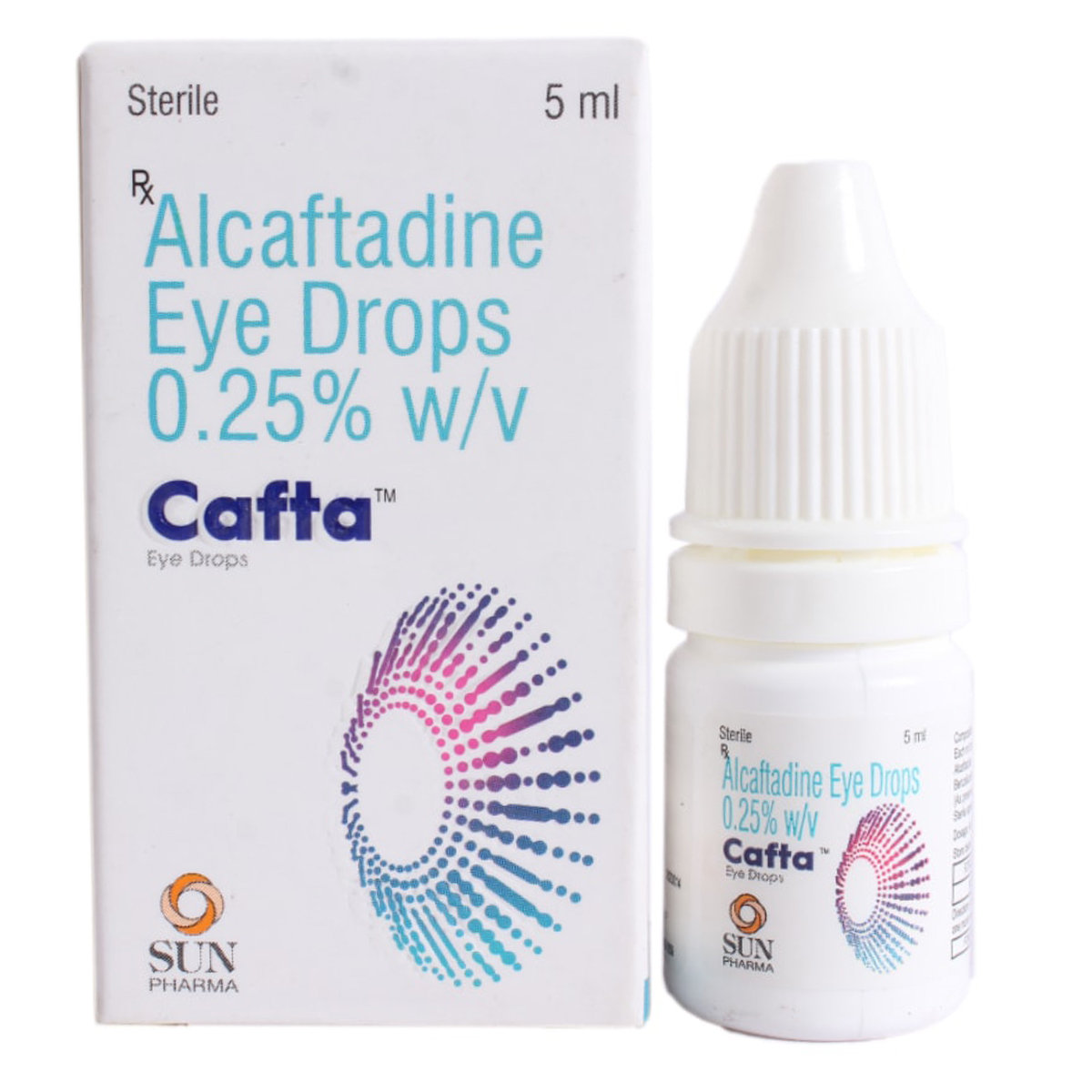Caftadine Eye Drops 5 ml










MRP ₹246.5
(Inclusive of all Taxes)
₹37.0 Cashback (15%)
Provide Delivery Location
Online payment accepted
 Prescription drug
Prescription drugWhats That
Composition :
Manufacturer/Marketer :
Consume Type :
Expires on or after :
Return Policy :
About Caftadine Eye Drops 5 ml
Caftadine Eye Drops 5 ml belongs to a class of antihistamine, and it is primarily used to treat itching/irritation of the eyes due to allergic conjunctivitis. Allergic conjunctivitis is a quite common eye inflammation caused by an allergic reaction from allergens, especially during hay fever season. Its body’s reaction against substances it considers as potentially harmful.
Caftadine Eye Drops 5 ml contains Alcaftadine. It works by blocking the release of histamine, which is responsible for allergic symptoms. Caftadine Eye Drops 5 ml comes in ophthalmic dosage form (eye drops).
Caftadine Eye Drops 5 ml is for external use only. If you wear contact lenses, remove it before using Caftadine Eye Drops 5 ml, and you can put it back 10 minutes after using Caftadine Eye Drops 5 ml. You may experience irritation in the eyes, headache, mild taste, swelling of the inside of the nose and throat in some cases. Most of these side effects of Caftadine Eye Drops 5 ml are temporary, do not require medical attention, and gradually resolve over time. However, if the side effects are persistent, reach out to your doctor.
Take Caftadine Eye Drops 5 ml only if the doctor prescribes you. Never encourage self-medication or suggest your medicine to someone else. Also, do not use Caftadine Eye Drops 5 ml to treat irritation of the contact lens. It would be best to stop taking Caftadine Eye Drops 5 ml abruptly as it may worsen your symptoms. Do not take Caftadine Eye Drops 5 ml if you are allergic to Caftadine Eye Drops 5 ml or any ingredient of Caftadine Eye Drops 5 ml. Do not take any other eye medication along with Caftadine Eye Drops 5 ml without talking to your doctor. Before using Caftadine Eye Drops 5 ml, inform your doctor if you have or ever had glaucoma (increased eye pressure), any other eye problem, or if you are pregnant or breastfeeding.
Uses of Caftadine Eye Drops 5 ml
Directions for Use
Key Benefits
Caftadine Eye Drops 5 ml contains Alcaftadine, and it is an H1 histamine receptor antagonist. It is used to treat itching of the eyes due to allergies. It works by inhibiting the natural substance (histamine) action that is responsible for causing allergic symptoms. Due to the release of histamine, symptoms such as itching of the eyes can be seen.
Storage
- Eat a healthy, well-balanced diet full of vitamins, minerals, and omega-3 fatty acids to help maintain eye health.
- Wear UV-protecting sunglasses when you are outside or in bright light.
- Avoid touching or rubbing your eyes it may increase irritation.
- Seek medical care if you are experiencing extreme eye pain or discomfort.
- Burning sensation is an abnormal side effect that needs medical attention. To relieve the burning feeling, your doctor may prescribe painkillers or antidepressants.
- Focused exercises can improve strength and reduce burning by soothing muscles.
- Change in lifestyle and improving nutrition can reduce the causes of burning sensation and provide relief.
- Your doctor may suggest nerve block injections as it is related to sensation in the skin.
- Burning feeling in a specific area would need mild electrical currents to reduce pain that targets the nerve affected. This practice must be done only if your doctor mentions it.
- Burning sensation at the instillation site is an abnormal side effect that needs medical attention.
- Focused exercises or massaging that particular organ slowly can reduce pain.
- Do not retake the same medicine that caused a burning sensation.
- Burning feeling in a specific area would need relaxing that particular part. Talk to your doctor before applying a cold compress.
- To soothe and calm the eyes, apply a cool compress to the affected area.
- Avoid touching or rubbing the eyes, as this can irritate them further and prolong redness.
- Stay away from environmental irritants like smoke, dust, and harsh chemicals.
- Get plenty of rest and try to manage stress, as fatigue and tension can contribute to eye redness.
- Take regular breaks from digital devices to give the eyes a chance to rest.
- Wash hands regularly to prevent the spread of infection.
- Applying a cold compress can soothe the inflamed portion and reduce itching.
- Wear wraparound sunglasses to protect your eyes from wind, dust, and pollen.
- Gently wash the eyelids using mild soap with lukewarm water to wash away dirt and bacteria.
- Avoid rubbing the eyes or eyelids to prevent the inflammation.
- Keep contact lenses clean and disinfected to avoid infection.
- See a doctor again if changes in your vision or eye symptoms occur.
- Inform your doctor about the common cold symptoms you're experiencing due to medication.
- Your doctor may adjust your treatment plan, which could include changing your medication, adding new medications, or offering advice on managing your symptoms.
- Practice good hygiene, including frequent handwashing, avoiding close contact with others, and avoiding sharing utensils or personal items.
- Drink plenty of fluids, such as warm water or soup, to help thin out mucus.
- Get plenty of rest and engage in stress-reducing activities to help your body recover. If your symptoms don't subside or worsen, consult your doctor for further guidance.
- Hydrate your body: Drink enough water to prevent dehydration and headaches.
- Calm Your Mind: Deep breathing and meditation can help you relax and relieve stress.
- Rest and Recharge: Sleep for 7-8 hours to reduce headache triggers.
- Take rest: lie down in a quiet, dark environment.
- Cold or warm compresses can help reduce tension.
- Stay Upright: Maintain good posture to keep symptoms from getting worse.
- To treat headaches naturally, try acupuncture or massage therapy.
- Over-the-counter pain relievers include acetaminophen and ibuprofen.
- Prescription Assistance: Speak with your doctor about more substantial drug alternatives.
- Severe Headaches: Seek emergency medical assistance for sudden, severe headaches.
- Frequent Headaches: If you get reoccurring headaches, consult your doctor.
- Headaches with Symptoms: Seek medical attention if your headaches include fever, disorientation, or weakness.
Drug Warnings
Inform your doctor if you are allergic to Caftadine Eye Drops 5 ml or any of the ingredients of Caftadine Eye Drops 5 ml, what other prescription and non-prescription medications, vitamins, nutritional supplements, and herbal products you are taking. Please do not stop taking Caftadine Eye Drops 5 ml suddenly, as it might worsen your symptoms. Do not swallow this medication as it may cause harm if swallowed, Caftadine Eye Drops 5 ml is intended for use in the eye only. Wash your hands before and after instilling Caftadine Eye Drops 5 ml. To avoid any contamination, avoid touching the tip of the dropper. Do not put to eye medication simultaneously; wait for at least 5-10 minutes before putting in the second medication. If you develop/notice a new eye infection or injury, inform your doctor, change in eyesight, or awful (very bad) eye irritation after using Caftadine Eye Drops 5 ml.
Drug-Drug Interactions
Drug-Drug Interactions
Login/Sign Up
Drug-Food Interactions
Drug-Food Interactions
Login/Sign Up
Diet & Lifestyle Advise
- Avoid alcoholic beverages with Caftadine Eye Drops 5 ml as they can make you dehydrated and affect eye's pressure.
- Visit an optician regularly.
- Try to include heart-healthy omega-3 fatty acid-containing food drinks in your daily diet. You can also use low-fat cooking oil like olive oil, soybean oil, canola oil, and coconut oil.
- Regular moderate exercise and appropriate rest are important for a speedy recovery.
- Fruits and vegetables, which contain vitamins A and C, help improve vision.
- Include dairy foods in your diet that may improve eye health.
- Indulge yourself in aerobic exercise that relaxes eye muscles and the pressure built inside them.
- Consume more leafy vegetables, including cabbage, kale, and spinach, that improves eye health and lowers the risk of glaucoma.
Side Effects of Caftadine Eye Drops 5 ml
- Eye irritation
- Itching, burning, or stinging of the eye
- Eye redness
- Runny nose
- Headache
Habit Forming
Therapeutic Class
All Substitutes & Brand Comparisons
RX
Alcaft Eye Drops 5 ml
Micro Labs Ltd
₹240
(₹43.2/ 1ml)
2% CHEAPERRX
Out of StockAlcaeye Eye Drops 5 ml
Cioun Healthcare Pvt Ltd
₹220
(₹44.0/ 1ml)
RX
Cafta Eye Drops 5 ml
Sun Pharmaceutical Industries Ltd
₹280
(₹50.4/ 1ml)
13% COSTLIER
Product Substitutes
Author Details
We provide you with authentic, trustworthy and relevant information
Drug-Diseases Interactions
Drug-Diseases Interactions
Login/Sign Up
FAQs
Yes, Caftadine Eye Drops 5 ml is known to cause eye irritation. Caftadine Eye Drops 5 ml contains a preservative Benzalkonium chloride, which is known to cause eye irritation. If it becomes severe, please visit your doctor immediately.
No, Caftadine Eye Drops 5 ml should be taken in the dose and duration as advised by the doctor. If you take it in more than the recommended dose, it might cause serious side effects. If you think your symptoms are not improving, please consult your doctor.
If you miss a dose of Caftadine Eye Drops 5 ml, take the missed dose as soon as you remember it. However, if it's almost time for the next dose, do not take a double dose to make up for a missed one.
Caftadine Eye Drops 5 ml belongs to a class of medicines known as an antihistamine. It works by inhibiting the natural substance (histamine) action responsible for causing allergic symptoms, thereby reducing allergy symptoms.
Caftadine Eye Drops 5 ml may cause blurred vision. However, this effect will be temporarily seen after instilling Caftadine Eye Drops 5 ml and gradually will wear off. Do not drive until you can see clearly.
No, avoid wearing contact lenses for at least 10 minutes after instilling Caftadine Eye Drops 5 ml. This is because Caftadine Eye Drops 5 ml contains benzalkonium chloride (preservative) which may be absorbed by contact lenses.
No, Caftadine Eye Drops 5 ml should not be used simultaneously with other eye medications. At least, a gap of 10-15 minutes should be there between using two eye medications.
Special Advise
- Remove your contact lenses before using Caftadine Eye Drops 5 ml to avoid any unpleasant side effects.
- Do not put two eye drops together. Try to maintain a gap of at least 5-10 minutes between the two eye drops.
Disease/Condition Glossary
Allergic conjunctivitis: Allergic conjunctivitis is a quite common eye inflammation that happens when your eyes come into contact with an allergen. Symptoms such as itching, redness of the eyes can occur because the overreacting immune system causes the body to release histamine and other active substances. As a result, the blood vessels dilate or expand, irritates the nerve endings. Allergic conjunctivitis is different from infective conjunctivitis.

Have a query?
Buy best Ocular products by
Entod Pharmaceuticals Ltd
Ajanta Pharma Ltd
Sunways (India) Pvt Ltd
Sun Pharmaceutical Industries Ltd
Cipla Ltd
Micro Labs Ltd
Allergan Healthcare India Pvt Ltd
Intas Pharmaceuticals Ltd
Raymed Pharmaceuticals Ltd
Nri Vision Care India Ltd
FDC Ltd
Jawa Pharmaceuticals India Pvt Ltd
Indoco Remedies Ltd
Sapient Laboratories Pvt Ltd
Senses Pharmaceuticals Pvt Ltd
Centaur Pharmaceuticals Pvt Ltd
Neomedix Healthcare India Pvt Ltd
Aromed Pharmaceuticals
Optho Remedies Pvt Ltd
Aurolab
Austrak Pvt Ltd
Lupin Ltd
Mankind Pharma Pvt Ltd
Zivira Labs Pvt Ltd
Optho Pharma Pvt Ltd
Synovia Life Sciences Pvt Ltd
Akumentis Healthcare Ltd
Eyekare
His Eyeness Ophthalmics Pvt Ltd
Protech Remedies Pvt Ltd
Runyon Pharmaceutical Pvt Ltd
Alcon Laboratories Inc
Syntho Pharmaceuticals Pvt Ltd
Alembic Pharmaceuticals Ltd
Bell Pharma Pvt Ltd
Klar Sehen Pvt Ltd
Sentiss Pharma Pvt Ltd
Irx Pharmaceuticals Pvt Ltd
Optho Life Sciences Pvt Ltd
Phoenix Remedies Pvt Ltd
Alkem Laboratories Ltd
Doctor Wonder Pvt Ltd
Hicare Pharma
Ipca Laboratories Ltd
Neon Laboratories Ltd
Okulus Drugs India
Pharmtak Ophthalmics (I) Pvt Ltd
Berry & Herbs Pharma Pvt Ltd
Glow Vision Pharmaceuticals
Kaizen Drugs Pvt Ltd
Choroid Laboratories Pvt Ltd
Indiana Opthalamics Pvt Ltd
Optica Pharmaceutical Pvt Ltd
Pharmatak Opthalmics India Pvt Ltd
Samarth Life Sciences Pvt Ltd
Vibgyor Vision Care
Mofon Drugs
Novartis India Ltd
Pharmia Biogenesis Pvt Ltd
Zydus Cadila
Appasamy Ocular Devices Pvt Ltd
Leeford Healthcare Ltd
Medivision Pharma Pvt Ltd
Orbit Life Science Pvt Ltd
X-Med Royal Pharma Pvt Ltd
Zee Laboratories Ltd
Aarma Laboratories
Guerison MS Inc
Laborate Pharmaceuticals India Ltd
Xtas Pharmaceuticals
Accurex Biomedical Pvt Ltd
Blucrab Pharma Pvt Ltd
Does Health Systems Pvt Ltd
Flagship Biotech International Pvt Ltd
Lavue Pharmaceuticals Pvt Ltd
Nutrilis Healthcare Pvt Ltd
Ursa Pharm India Pvt Ltd
Vee Remedies
Vyonics Health Care India Pvt Ltd
Warren Pharmaceuticals Pvt Ltd
Abbott India Ltd
Accvus Pharmaceuticals
Akums Drugs & Pharmaceuticals Ltd
Cadila Healthcare Ltd
Carevision Pharmaceuticals Pvt Ltd
Dey's Medical Stores (Mfg) Ltd
East West Pharma India Pvt Ltd
Eyedea Pharmaceuticals Pvt Ltd
Nimbus Healthcare Pvt Ltd
Ocuris Pharmaceuticals Pvt Ltd
Sherings Pharmaceuticals
Tarks Pharmaceuticals Pvt Ltd
Vcan Biotech
Vision Medilink
Aice Health Care Pvt Ltd
Appasamy Pharmaceuticals Pvt Ltd
Asperia Lifescience Pvt Ltd
Beatum Healthcare Pvt Ltd
East India Pharmaceutical Works Ltd
Grevis Pharmaceutical Pvt Ltd
Alcohol
Safe if prescribed
Avoid alcoholic beverages with Caftadine Eye Drops 5 ml as it can make you dehydrated and affect the eye's pressure.
Pregnancy
Consult your doctor
There are no adequate and well-controlled studies on pregnant women. A Caftadine Eye Drops 5 ml should be used during pregnancy only if prescribed by a doctor if he/she thinks the potential benefit justifies the fetus's potential risk.
Breast Feeding
Consult your doctor
There are no adequate and well-controlled studies in breastfeeding women. Caution should be exercised, and it is advisable to consult a doctor before using it.
Driving
Safe if prescribed
Caftadine Eye Drops 5 ml can cause blurry vision. So, driving or operating machinery should not be done.
Liver
Consult your doctor
No interaction was found. Please consult your doctor for further advice.
Kidney
Consult your doctor
No interaction was found. Please consult your doctor for further advice.
Children
Safe if prescribed
It is well tolerated in children when used as advised by the child specialist.







